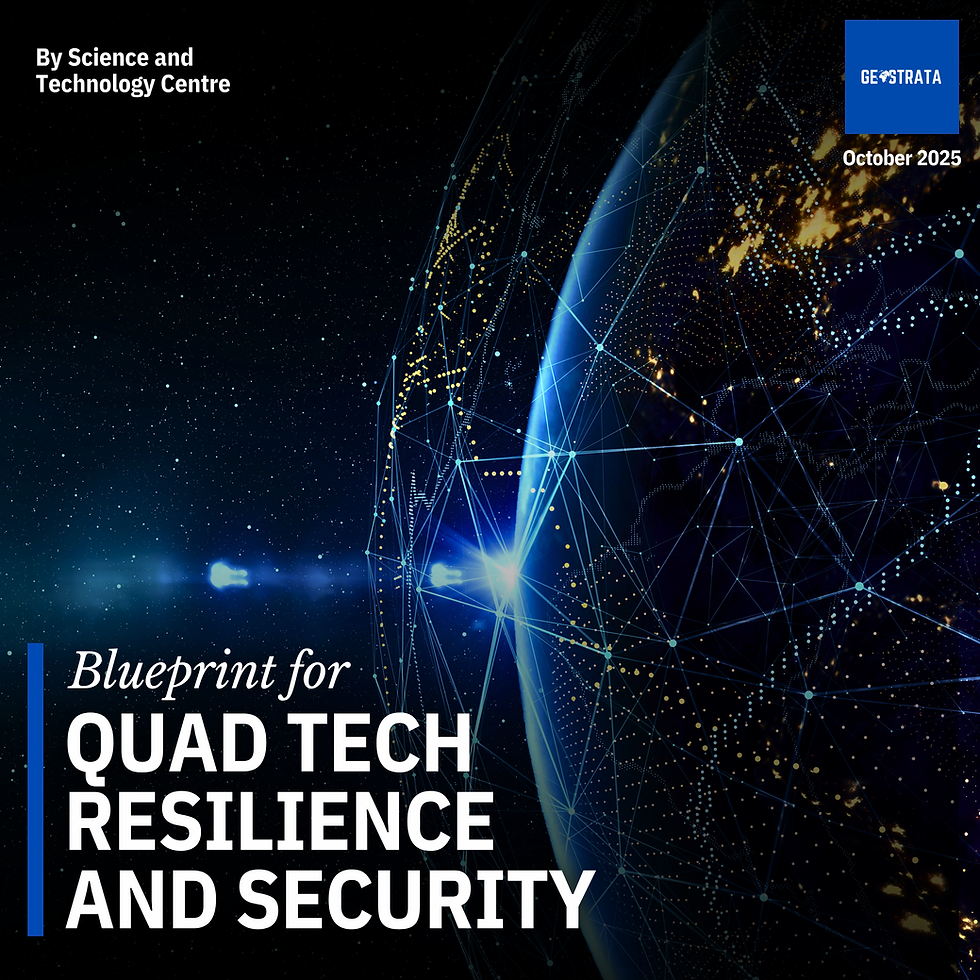Chandrayaan 3: Dawn of New India
- THE GEOSTRATA

- Aug 24, 2023
- 4 min read
Updated: Oct 9, 2023
“We are a way for the cosmos to know itself.”
~ Carl Sagan
"We have achieved a soft landing on the moon; India is on the moon,” were the words of Shri S. Somanath, Chairman ISRO, in the aftermath of the success of the Chandrayaan 3 mission. It was a moment of awakening for the collective conscience of the 140 crore people of India. India became the fourth country to land on the surface of the moon and the first country to conduct a successful landing on the South Pole of the lunar surface.

Illustration by The Geostrata
As ISRO gears up for future missions such as Aditya-L1 and Gaganyaan (India’s first manned mission in space), it is worth analysing the historical intricacies and geopolitical implications of India’s space exploration.
साइकिल से चांद तक (FROM BICYCLE TO THE MOON)
After establishing INCOSPAR (Indian National Committee for Space Research) in 1962, the establishment of Thumba Equatorial Rocket Launching Station (TERLS) in 1963 marked the genesis of India’s space exploration journey. In the same year, our scientists launched the Nike Apache rocket, the one image that is engraved in our minds is the one where ISRO scientists were carrying this rocket on the bicycle for the assembly of this mission. In the next few years, ISRO launched many missions, such as Aryabhatta, Bhaskara-I, and Rohini, along with SLV, PSLV, and GSLV launch vehicles, advancing India's journey to become a leading space power.
With the Vikram lander on the surface of the moon, India will lead lunar exploration of the south pole by collecting various data, which will also help future moon missions of different countries, including Artemis-II.
Leaders across the world, from H.E. Ursula von der Leyen to HH Mohammed bin Zayed Al Nahyan and from H.E. Mr Nikol Pashinyan to H.E. Pushpa Kamal Dahal, among others, have congratulated India and ISRO for this magnificent achievement.
The budget of ISRO for Chandrayaan 3 was around $75 million, which was reportedly less than the Hollywood movie Interstellar. The cost-effectiveness that our organisation has shown is commendable at the next level.
GEOPOLITICAL IMPLICATIONS
One can remember how the geopolitical rivalries during the Cold War led to advancements in the US’ space journey vis-à-vis the Soviet Union via the Apollo missions. While the objective of Chandrayaan 3 is purely scientific, it does include some geopolitical dimensions.
By beating potential adversaries such as China in the race, the mission makes India the first country in the world to conquer the southern lunar pole. Additionally, it also gives India a strategic edge while engaging with different countries in the space sector.
During the 15th BRICS Summit in Johannesburg, one of the key suggestions that PM Modi made was the creation of a BRICS Space Exploration Consortium, which will work on the capacity building of the scientists along with advancing cooperation in areas like space research and weather monitoring in addition to global south cooperation in space research. ISRO’s expertise in this area can help in achieving such goals.
Further, due to the cost-effectiveness of ISRO projects in the commercial sector, it will become a viable option for different countries to send their satellites and use ISRO’s rockets for their space missions. Israel, the UAE, Japan, and many ASEAN countries have shown interest in such cooperation.
ROLE OF THE PRIVATE SECTOR
The private sector plays as important a role as any government agency when it comes to space exploration. As mentioned earlier, the genesis of space programmes is intertwined with Cold War geopolitical rivalries and their use in the military domain. However, with the advent of the technological age, space has become an arena for state and non-state entities to compete and explore for the common good of humanity.
Elon Musk’s SpaceX, the Blue Origin of Jeff Bezos, and even Skyroot Aerospace & Agikul Cosmos of India are good examples of how the private sector has played a significant role in space advancement. Strategic scholar C. Raja Mohan rightly puts it, "The private sector’s rise has been complemented by growing international cooperation to realise the new commercial possibilities in space."
FUTURE MISSIONS
As per the statement given by ISRO Chairman S. Somanath, the next major mission of ISRO will be Aditya-L1, which will be India’s first space-based mission to study the Sun. It aims to put a satellite in the halo orbit around the sun-earth system near Lagrange point 1 (L1). L1 is a place that will allow the satellite to observe the sun without any occultation or eclipse, giving the advantage of observing solar activities in real-time.
In addition to Aditya-L1, the major focus of ISRO will also be on Project Gaganyaan, which, by launching a mission crew, aims to demonstrate human spaceflight capability. A high level of technological advancement is undergoing due to the involvement of human elements in the operationalization of this mission.
ISRO has become a preferred and reliable space partner for international joint space collaboration, and we can also expect bilateral space exploration projects between India and different countries such as the US, Japan, and the EU.
CONCLUSION
Psychologically, it may be possible that the crash of Luna-25 has magnified the success of Chandrayaan 3. However, the effortless work that our scientists and engineers have done deserves deep respect. As Prime Minister Modi has said, "India's successful Chandrayaan-3 moon landing 'belongs to all of humanity’."
As we have ushered in the era of artificial intelligence, future missions of ISRO will include elements of AI that can help us materialise such technology in the space domain. With state-of-the-art technology and the brilliance of our scientists, the forthcoming missions of ISRO will be watched closely not only by us Indians but also by the entire globe.
BY DARSHAN GAJJAR
TEAM GEOSTRATA
.png)







Comments